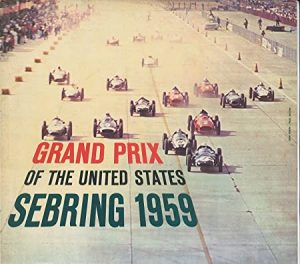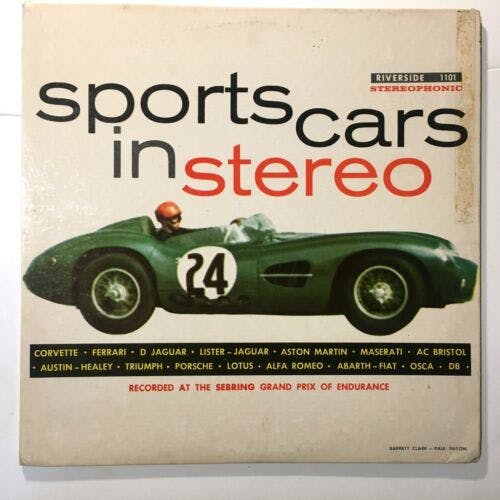Riverside Records captured the sounds of racing in the 1950s
In 1953, jazz aficionados Bill Grauer, Jr. and Orrin Keepnews started a record company called Riverside Records. Located in New York City, “Riverside” was a reference to either the Hudson or the East River; the historic racetrack in southern California wouldn’t be built until 1957. Regardless, the choice of the name would turn out to be fortuitous.
At the time, the recording industry was moving from 78 rpm discs to 45 rpm singles and 33 rpm long playing LP records. A number of less-than-ethical firms were pirating those old 78s and reissuing them, without licenses, on the new formats. Grauer and Keepnews’ business plan was to present licensing deals to the established record companies to reissue their old catalogs. By the late 1950s, Riverside had grown into one of the most important original jazz labels, with a lineup that was a veritable who’s who of the 1950s jazz world.
Jazz wasn’t Grauer’s only interest, though. He was a self-professed racing nut. Frequently attending the Sebring 12-hour races, he described them as “a terribly wonderfully exciting spectacle.”
Stereophonic recordings were new in the mid-1950s, and engineers would often record all sorts of non-musical sounds to demonstrate and experiment with the new three-dimensional audio technology. Sounds such as approaching trains and emergency-vehicle sirens seem to have been popular subjects. It’s not surprising, then, that someone who ran a record label and enjoyed car racing decided to take a recording crew down to Florida for the 1956 race at Sebring.
“[In] 1956, just for fun,” Grauer recollected, “we recorded sounds of sports-car races down at Sebring, Florida (I’m a racing nut, you know). We decided to release it and then the roof fell in. It began to sell like crazy.” RLP 5001, Sounds of Sebring: The 1956 Florida International Twelve-Hour Grand Prix of Endurance, was Riverside’s first automotive release.
Side one included interviews with drivers—many of whom are now icons of the sport, such as Juan Manuel Fangio and Stirling Moss—as well as audio recordings of Maseratis, Ferraris, Lotuses, and Porsches. Side two had a reproduced hour-by-hour broadcast of the race.
To modern folks accustomed to watching sporting events live and being able to catch up with just about anything they missed on YouTube or other streaming services, the idea of folks listening to a recording of interviews or reenacted races seems quaint. In an era when racing fans would find out race results days and sometimes even weeks after the events were over, the ability to listen to idolized drivers and their cars on repeat was exciting and quite novel.
To get an idea of how special these recordings are, look at the track listings for Sounds of Sebring 1959:
Side One Interviews with: Baron von Hanstein; Denise McCluggage; John Fitch; Edgar Barth; Joachim Bonnier; Carroll Shelby and Reg Parnell; Olivier Gendebien; Phil Hill; Briggs Cunningham; Stirling Moss; Count von Trips; Dan Gurney; Cliff Allison; Chuck Daigh.
Side Two Race Day … Le Mans Start; 11 O’Clock Report; Aston Martin (Reg Parnell) Pit Stop; 12 O’Clock Report; Lotus (Colin Chapman) Pit Stop; Olivier Gendebien; 2:30 p.m. Report; Phil Hill; Parnell; Baron von Hanstein and Joachim Bonnier; Chuck Daigh; Ferrari (Gurney/Gendebien) Pit Stop; 4 O’Clock Report; Tex Ash; 6 O’Clock Report; 7:30 p.m. Report; Ferrari (Behra/Allison) Pit Stop; Porsche (Bonnier/von Trips) Pit Stop; 8:30 p.m. Report; 10 O’Clock Report; The Victory Ramp.

A mid-race interview with Colin Chapman from Sebring in 1959? That’s the motorsports equivalent to Alan Lomax using a wire recorder to capture the music of Muddy Waters for the first time, back when Mr. Morganfield was still working on Stovall Plantation in Clarksdale, Mississippi. Real roots stuff, authentically archived history.
Sounds of Sebring was so successful that it spawned an entire series of “Sounds of” motorsports recordings. Riverside eventually released about 30 titles, advertising for them in the back of buff books such as Sports Car Illustrated and Road & Track, with copy like this:
For the first time ever: A superb high-quality 12-inch long-playing record of all the sounds that make up America’s greatest sports car race. Over 60 minutes of interviews with the world’s greatest drivers…Fangio, Moss, Collins, Behra, Hill, Musso, Menditeguy, Bennett, Rubirosa, Portago, Parnell. The sounds of Ferraris, Maseratis, Jags, Aston Martins, Porsche, Corvettes, Lotus, etc., warming up, revving, roaring at speed, coming out of corners flat out. The fabulous Le Mans start, pit activity, the fantastic sounds of Fangio shifting up and down as he makes the five-mile circuit, and dozens of other remarkable on-the-spot sounds which are so exciting to the driver and spectator alike.
From the drivers to the cars, Grauer seems to have known his stuff, as you can tell from whom he interviewed and what events his recordings covered. Entire albums were devoted to Phil Hill, the first American to win the Formula One world championship, and Carroll Shelby, recorded when he was known as one of the winners of the 1959 Le Mans, not as the creator of the Cobra. While he was clearly a road-racing enthusiast, Bill Grauer didn’t just like Formula One cars and sports cars. An entire Riverside subseries was devoted to hot rods and the drag-racing community. The project was a bit of a family affair for the Grauers, as Jane Grauer, Bill’s wife, created many of the artistic album covers.
Unfortunately, Bill Grauer died of a heart attack in 1963, so the series was discontinued. Today, Concord Records owns the rights to Riverside’s catalog, but it appears that its only current products are a Chet Baker box set and a John Lee Hooker reissue. As mentioned, however, Riverside’s car-records sold pretty well back in the day, so you can pick up many of the titles second-hand on eBay or from vintage-record dealers. Put one on your turntable, crank up the volume to 11, and you’re instantly teleported back to the glorious days of racing’s golden age.



